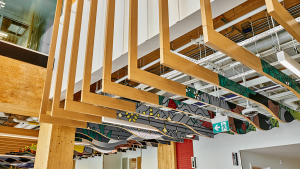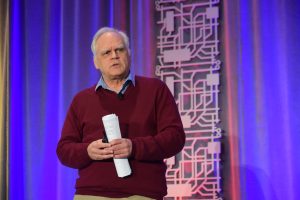A technical manual that tells how tall wood buildings can be designed as “alternative solutions” to achieve performance standards that meet the Ontario Building Code will help building officials, architects, developers and constructors move forward in a new era of building.
Ontario’s Tall Wood Building Reference, released late last year, offers a “distinctive Ontario-made solution” to the development, design and construction of tall wood buildings, said David Moses of Toronto-based Moses Structural Engineers, who co-authored the manual with Steven Craft, principal of CHM Fire Consultants Ltd., of Ottawa.
Moses, whose portfolio includes the trademark glulam wood structure on the Art Gallery of Ontario in Toronto, said tall wood buildings are cropping up in B.C., Quebec, the U.S. and around the world.
“We understood that our building codes are so slow to change that we had to do something different,” he said.
“We started to realize that there were target audiences that needed the assistance, to bridge this gap in knowledge.”
For cost efficiency, most tall wood buildings will be eight to 12-storeys but the manual does not define a height limit.
“It will be up to you to use the alternative solution process,” he told delegates recently at a workshop in Toronto hosted by Ontario Wood WORKS!
“Every building is going to be a little different (and it will take) a little while until we get some standardization.”
Moses noted that midrise and tall wood buildings are in an “infancy period where we are going to see a lot of new systems.”
The key is to design systems that still meet the performance standards in the building code.
We see this as an opportunity for some change. We’re looking at innovation and creating affordability in new buildings
— David Moses
Moses Structural Engineers

Questions about tall wood buildings include costing, not only for materials but also the speed of installation, he said.
“We’re still learning which systems will be cost effective,” said Moses. “We’re waiting for the trades to get up to speed so they can make it cost effective as well.”
Maintaining high safety and performance standards is paramount, he said, adding, “The safety of fire personnel entering these buildings is critical.”
Moses said the response by building officials to the manual has been positive.
“We see this as an opportunity for some change. We’re looking at innovation and creating affordability in new buildings,” he said.
Tall wood buildings fall into the category of alternative solutions — a design in compliance with the building code that differs from the norm in how it achieves compliance.
Moses said an optional path, to include tall wood buildings in the building code, would have taken years to achieve.
In the manual’s chapter on structure, the design of buildings for gravity, earthquakes and wind is covered. Stairs, elevators shafts and connections along with deflection, shrinkage, drift and other issues outside the structural strength of the building are also raised, said Moses.
Testing tall wood designs is also reviewed.
“There are new analytical techniques being developed for tall wood buildings,” he explained.
The structural engineer said today’s designers can learn from the century-old brick and timber manufacturing and warehouse buildings in Toronto, many of which have been repurposed for residential and commercial use.
Moses said the engineered wood movement has evolved from the 1980s when I-joists and laminated veneer lumber were targeted as “products” for non-commercial buildings. Connection technology followed in the 1990s and CNC machines that make “very precise” cuts came about in 2000. It took another decade for cross-laminated timber to catch on.
Moses said emphasis is now on training the trades for construction of tall wood buildings. His firm and other consultants have worked closely with the Carpenters’ Union and the College of Carpenters and Allied Trades in Vaughan, Ont. to develop modules to train framers.
The manual’s largest chapter deals with fire. Speaking to delegates at the Ontario Wood WORKS! workshop, CHM’s Craft said a building under alternative solutions must demonstrate that people in the building and adjacent buildings are safe from a fire.
Craft encouraged mass timber building designers to consult with fire experts at the design onset.
He said the first project in Canada to “go the full alternative solution process” has just started construction in downtown Vancouver. To be called Terrace House, it will be the world’s tallest hybrid wood structure.
Previously, projects such as Brock Commons at the University of B.C. were done using site specific regulations. The Province of B.C. modified the site to permit its construction.







Recent Comments
comments for this post are closed